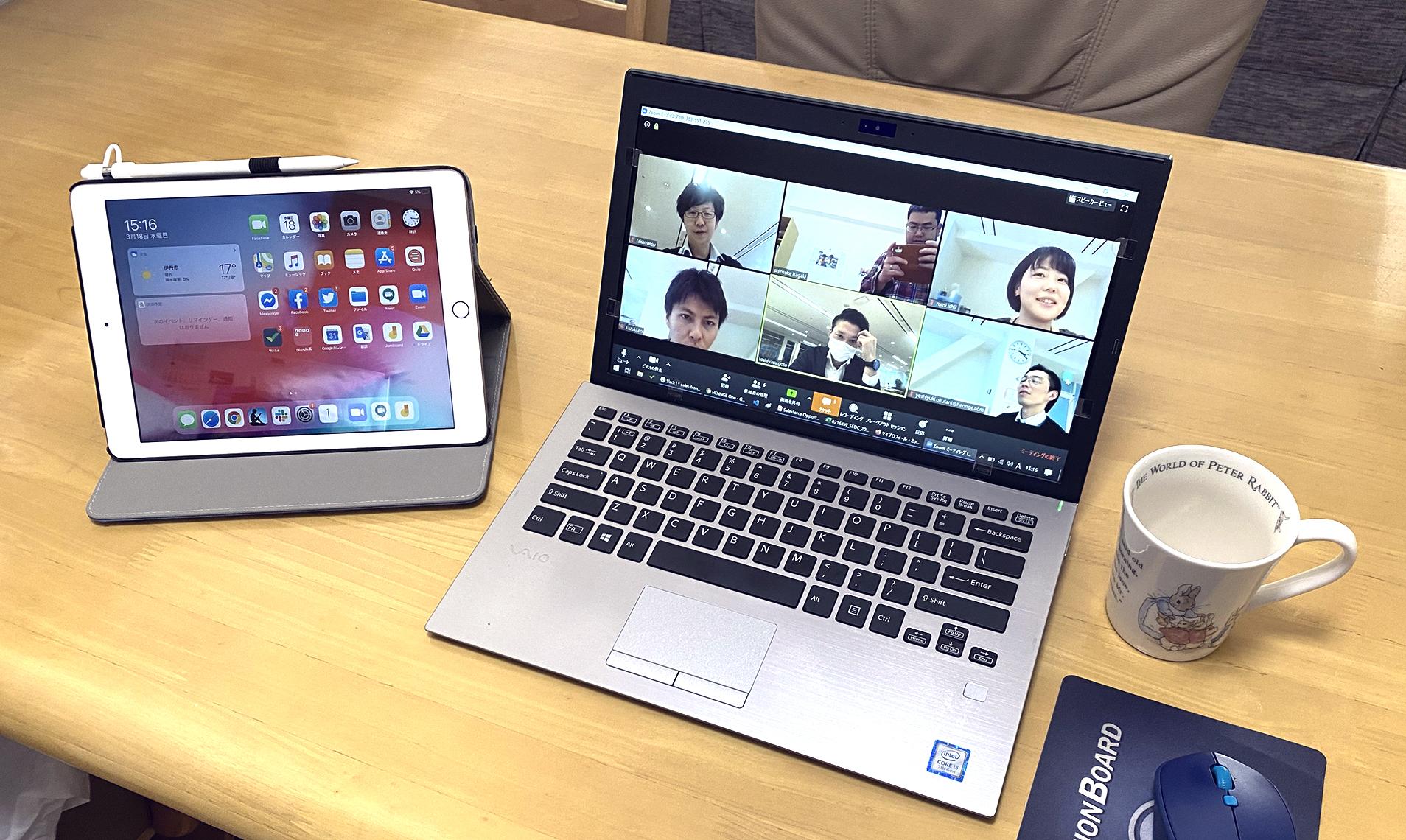

Yuya Yamamoto
Published on Feb 12, 2020

Remote working with Zoom.
Starting in February of 2020, the Customer Success Division Digital Intelligence Section switched to telecommuting in principle. Mr. Itagaki, the section Sales Strategist, recently talked with us about Zoom, a system used for telecommuting and teleconferencing.

To put it simply, we promote SaaS utilization by the Sales Department and Customer Success Department. Because HENNGE One uses a SaaS recurring business model, the work doesn’t end as soon as we sell a product or service. Measures that result in customers continuing to use our products for a long time after they are sold are necessary. We’re in charge of creating systems to achieve that.

HENNGE started recommending telecommuting in February of 2020, but were you able to smoothly transition to this style of work?

Yes, and one major reason is that I had already experienced telecommuting, though there was a limit of up to twice per week in my section. I suppose that experience helped me learn naturally what kind of an environment is necessary for telecommuting and provided the relevant training.
Thanks to that, I haven’t felt inconvenienced whatsoever. In addition, our section has been using SaaS task management tools and business chat tools for a while now, so I can still work with my colleagues as I always have, even if we’re apart.

You use an iPad to telecommute, right? Do you think the evolution of devices is important in terms of telecommuting?

Sure. There was actually quite a process of trial and error in terms of my device, but I have settled on the iPad for now. One reason for this is that it can be carried anywhere. In addition, there are no input problems because you can use a keyboard or Apple Pencil. Right now, we’re using the iPad teleconferencing app Zoom to talk, and the audio and video are clear, right? As long as this is possible, a person can telecommute anywhere.


I’ve heard that, when working from home, some people don’t like the fact that teleconferencing systems show the inside of their houses. However, based on what I’m seeing here, your background is extremely clean, so you don’t seem to have that problem. Are you doing anything special to achieve that?

As a matter of fact, I’m using a virtual background. With Zoom–in addition to the built-in backgrounds–you can use a photo of your own as a background. As long as you set up some scenery that looks natural at a glance, there’s no need to clean up your house. This is another advantage of using an iPad, and the background looks good even if you don’t use a green screen. Speaking of which, I have actually set up two backgrounds that I often use.


I see. That really does look completely natural.

The fact that these types of functions are added as necessary is another advantage of using Zoom.

At HENNGE, we’re able to use Google Hangouts Meet, Microsoft Teams, and other remote systems, as well as Zoom. It seems to me that many employees use Meet because you can link it with a calendar or Jamboard, but how do you decide which system to use when?

HENNGE’s thinking is to use G Suite as conveniently as possible, so I often use Meet for in-house purposes. Outside of our company, I usually select tools based on the needs of the other party, but recently there has been a drastic increase in the use of Zoom. I suspect that the number of Zoom users has been increasing rapidly over the past several years.

Well, Zoom’s video is extremely clear, and its communication is stable, isn’t it?

I think the high-quality video is one of Zoom’s advantages. And yet the amount of data it uses is extremely small. That makes it possible to connect stably even with a home network connection or mobile network connection. That might be a major reason it’s recognized and so many people are choosing Zoom.
With Zoom, the connection is stable even in the case of conferences involving dozens of people or seminars with around one hundred people. With some teleconferencing systems, you have to turn off videos of participants if there are a lot of people participating in the conference. Such tools are inferior to Zoom in terms of usability.

Another feature of Zoom is the extent to which it can be used for free. For example, even in the case of a meeting involving multiple people, the first 40 minutes are free. I suspect that this has helped increase the number of users as well.

Forty minutes is a bit too short for a general meeting, but we can finish a meeting in time if we cut it down to the essentials. I’ve even heard that–thanks to this time limit–people have been able to shorten their meetings.

The amount of time spent on meetings really has decreased since we started using Zoom. It seems like conference participants are cooperating more actively as well. That has led to increased productivity.
Another thing that’s nice about Zoom is how easy it is to prepare for a conference. With conventional teleconferencing systems, it takes a lot of time to get ready and hook everything up, and just getting started was a hassle. In contrast, with Zoom, you can have a conference as soon as you think of a reason to, right?

I think that up until now a lot of teleconferencing systems involved connecting one room to another. Web-based conference tools seemed more like sub-tools than anything else. However, due to technological development and faster network speeds, web-based conference tools have become the main communication tools to use.

Are there any Zoom functions that you find particularly useful?

With Zoom, when you save data locally, you can save the audio data of each participant separately. This is extremely useful for referring to the comments of only specific people. In addition–depending on your contract–the system will automatically transcribe speech, though only English is currently supported. This type of function seems especially easy to use.

That really does sound useful. I’ve actually been using Zoom’s recording function to study English myself. HENNGE’s official in-house language is English, after all. The English spoken by employees is easy to understand because it is directly connected to work, but there are times when I suspect that there was probably a clearer way to convey what I wanted to say, so I use recordings to review such things.

Part of HENNGE’s culture is to take on new challenges. To do this, it’s essential to keep on absorbing new knowledge. Naturally, some things can’t be understood simply by looking them up online. In my own case, I participate both in the community and in seminars to absorb new knowledge.
In the past, most such events were offline, but there has been a recent shift toward holding them online. For example, you can now easily participate in events from Osaka that you once had to go to Tokyo for. If the use of Zoom becomes more widespread, I suspect that this trend will only accelerate.

Have you encountered any particular issues while telecommuting?

It might seem paradoxical, but I have become aware of the advantages of going to the office. Some things that were easy to do up until now are pretty hard when working from home.
One example is exercise. Now that I have stopped commuting to work, the number of steps I take per day has decreased to less than half. I have actually been counting the number of steps I take by using Dragon Quest Walk, but it has become clear that–unless I start exercising for real–I won’t reach the number of steps I was taking before.
I feel that this is a big issue in terms of staying healthy. I have also lost the ability to chat with employees and team members. Regardless of how convenient Zoom is, it would be weird to suddenly invite someone to Zoom just because you want to chat. I have recently been feeling just how important it is to meet people face-to-face in the same place and exchange a few words here and there, in terms of creating a sense of unity as a team.

With telecommuting, result-based management also becomes necessary, right? I suspect that conventional time-based management approaches are often difficult in the case of telecommuting. Now that you have actually implemented telecommuting, do you have any comments from the management perspective?

Well, I think you’re right about the conventional time-based management approach being unsuitable for telecommuting. After all, it seems odd to say that someone is being managed because video of them working is constantly being recorded by Zoom. What’s really important when it comes to telecommuting is a relationship of trust based on a belief that people can do their jobs.
Telecommuting can be realized when people are able to assign each other work because they trust each other. In this sense, I think it would take a lot of effort to have new employees with little working history telecommute from the start. Until a relationship of trust has been established, at least to a certain extent, I don’t think telecommuting works that well.

Right. You definitely have a point there. Anyway, thank you for taking the time to talk to us today.
Please visit HENNGE Blog to read more about HENNGE’s thoughts and changes.

Yuya Yamamoto
Published on Feb 12, 2020
What kind of work does the Customer Success Division Digital Intelligence Section handle for HENNGE?